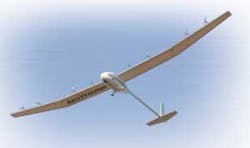By John McHale
BALTIMORE - The Global Observer, a liquid-hydrogen-powered unmanned aerial vehicle (UAV), has completed flight tests.
Officials at AeroVironment in Monrovia, Calif., made the announcement regarding their Global Observer High-Altitude Long-Endurance (HALE) system earlier this summer at the Association for Unmanned Vehicle Systems International (AUVSI) Unmanned Systems North America 2005 conference and trade show in Baltimore.
AeroVironment’s Global Observer HALE aircraft will be able to operate at altitudes as high as 65,000 feet for more than a week without refueling and with a flexible payload-carrying capacity of as much as 1,000 pounds, AeroVironment officials say.
The Global Observer liquid-hydrogen-powered unmanned aerial vehicle from AeroVironment can provide persistent stare capability at altitudes as high as 65,000 feet.
The flight tests were conducted with a one-third- to one-fifth-scale prototype of the liquid-hydrogen-powered aircraft, company officials say. The Global Observer is AeroVironment’s successor to its Helios solar-powered unmanned aircraft.
The Global Observer enables persistent stare capability for reconnaissance and surveillance missions. The UAV has more than quadruple the endurance of existing aerial options, which means fewer operating platforms and personnel are needed to sustain a 24-hour, seven-days-a-week persistent stare capability with the Global Observer system, resulting in lower cost and increased fidelity, AeroVironment officials say.
Using a minimum of only two aircraft in rotation, with one Global Observer replacing the other on station once per week, this capability will provide seamless communication relay and remote sensing systems at breakthrough affordability. An additional third platform could be used either as a spare or to expand mission coverage, company officials say.
Government and commercial applications include persistent, global, near-space loitering capability for defense and homeland security missions; low-cost, rapidly deployable telecommunications infrastructure and GPS augmentation; hurricane/storm tracking, weather monitoring, and wildfire detection/support; and environmental monitoring, agriculture optimization, and aerial imaging/mapping capabilities.
Other mission capabilities and payloads for HALE aircraft include detection and location of electromagnetic interference; tactical on-station weather monitoring and data; opportunity for dynamic tasking to theater commanders; global positioning augmentation for high-power anti-jam/jammer tracking; communications augmentation/bandwidth expansion; offensive information warfare; and dedicated communications support to other unmanned aerial vehicles.
In addition to validating the airplane and its propulsion system, these flight tests demonstrated safe and efficient hydrogen-powered flight and mobile liquid-hydrogen fueling operations, the last technology challenge for the Global Observer system, AeroVironment officials say.
The aircraft fuselage contains the liquid-hydrogen fuel-cell propulsion system, which powers eight motors mounted along a 50-foot wing. The full-size aircraft would have a wingspan of between 15 and 250 feet.
The Global Observer prototype accomplished a successful maiden liquid-hydrogen-powered flight on May 26 .
For more information visit www.aerovironment.com.

